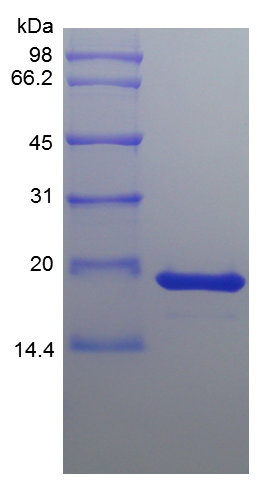- Synonyms
- HST, HST-1, HSTF-1, HBGF-4, Transforming Protein KS3
- Source
- Escherichia coli.
- Molecular Weight
- Approximately 19.8 kDa, a single non-glycosylated polypeptide chain containing 182 amino acids.
- AA Sequence
- GRGGAAAPTA PNGTLEAELE RRWESLVALS LARLPVAAQP KEAAVQSGAG DYLLGIKRLR RLYCNVGIGF HLQALPDGRI GGAHADTRDS LLELSPVERG VVSIFGVASR FFVAMSSKGK LYGSPFFTDE CTFKEILLPN NYNAYESYKY PGMFIALSKN GKTKKGNRVS PTMKVTHFLP RL
- Purity
- > 96 % by SDS-PAGE and HPLC analyses.
- Biological Activity
- Fully biologically active when compared to standard. The ED50 as determined by thymidine uptake assay using FGF-receptors transfected BaF3 cells is less than 0.5 ng/ml, corresponding to a specific activity of > 2.0 × 106 IU/mg.
- Physical Appearance
- Sterile Filtered White lyophilized (freeze-dried) powder.
- Formulation
- Lyophilized from a 0.2 µm filtered concentrated solution in 1 × PBS, with 350 mM NaCl, 5% trehalose and 0.02% Tween-20, pH 7.0.
- Endotoxin
- Less than 1 EU/µg of rHuFGF-4 as determined by LAL method.
- Reconstitution
- We recommend that this vial be briefly centrifuged prior to opening to bring the contents to the bottom. Reconstitute in 500 mM NaCl to a concentration of 0.1-1.0 mg/mL. Stock solutions should be apportioned into working aliquots and stored at ≤ -20 °C. Further dilutions should be made in appropriate buffered solutions.
- Stability & Storage
- Use a manual defrost freezer and avoid repeated freeze-thaw cycles.
- 12 months from date of receipt, -20 to -70 °C as supplied.
- 1 month, 2 to 8 °C under sterile conditions after reconstitution.
- 3 months, -20 to -70 °C under sterile conditions after reconstitution.
- Usage
- This material is offered by Shanghai PrimeGene Bio-Tech for research, laboratory or further evaluation purposes. NOT FOR HUMAN USE.
- SDS-PAGE

- Reference
- 1. Galland F, Stefanova M, Lafage M, et al. 1992. Cytogenet Cell Genet. 60:114-6.
2. Ornitz DM, Xu J, Colvin JS, et al. 1996. J Biol Chem. 271:15292-7.
3. Boulet AM, Capecchi MR. 2012. Dev Biol. 371:235-45.
- Background
- FGF-4, also named FGFK and KFGF, belongs to the fibroblast growth factor (FGF) family. By signaling through the FGF R1c, 2c, 3c and 4 receptors, FGF-4 has functions that maintain a population of progenitor cells in the epiblast that generates mesoderm, and contribute to the stem cell population that is incorporated in the tailbud. It is also required for axial elongation of the mouse embryo after gastrulation. Mature human FGF4 (71206 a.a.) shares 91 %, 82 %, 94 % and 91 % a.a. identity with murine, rat, canine and bovine FGF4. Additionally, FGF-4 shares about 30 % sequence identity with the prototypical members of the FGF family.

 COA申请
COA申请
